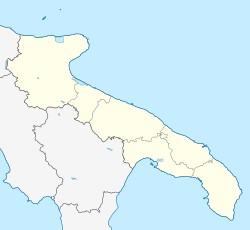
Molfetta is a town located in the northern side of the Metropolitan City of Bari, Apulia, southern Italy.

The province of Foggia is a province in the Italian region Apulia.
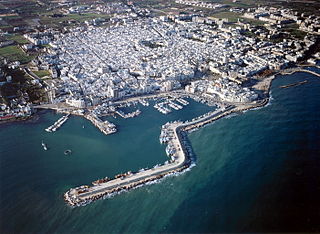
Mola di Bari, commonly referred to simply as Mola, is a town and comune of the Metropolitan City of Bari, in the region of Apulia, in Southern Italy, on the Adriatic Sea.

Manfredonia is a town and commune of Apulia, Italy, in the province of Foggia, from which it is 35 kilometres northeast by rail. Manfredonia is situated on the coast, facing east, to the south of Monte Gargano, and gives its name to the gulf to the east of it. As of 2017 its population was 56,932.

Manduria is a city and comune of Apulia, Italy, in the province of Taranto. With c. 32,000 inhabitants (2013), it is located 35 kilometres (22 mi) east of Taranto.

Oria is a town and comune in the Apulia region (Salento), in the province of Brindisi, in southern Italy. It is the seat of the Roman Catholic Diocese of Oria.

Francavilla Fontana is a town and comune (municipality) in the province of Brindisi and region of Apulia, in southern Italy. It is also called the town of the "Imperiali", after the Imperiali, a family of feudal lords who ruled the town from the end of 16th century until the 18th century. With a population of 36,358, in 2017, it is the third municipality of its province after Brindisi and Fasano. Its one of the many towns in south Italy where the Greek dialect Griko is spoken.
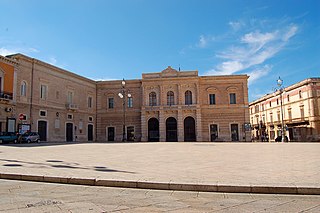
Fasano is a town and comune in the Province of Brindisi, Apulia, southern Italy. It is the second most populated town in the province after Brindisi, with a population in 2021 of 39,026.
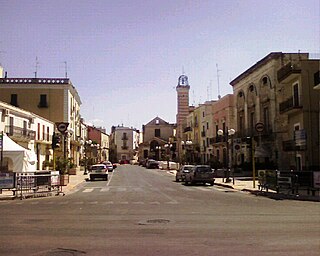
Modugno is a town and comune (municipality) of the Metropolitan City of Bari, Apulia, southern Italy. It borders the municipalities of Bari, Bitetto, Bitonto, Bitritto, and Palo del Colle.

Rutigliano is a town and commune in the Metropolitan City of Bari, Apulia, southern Italy.
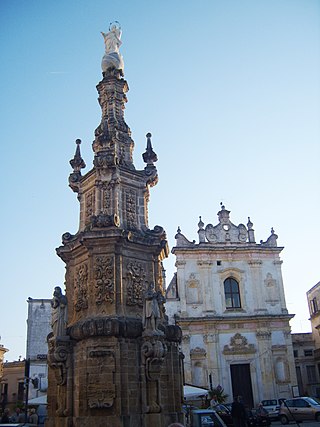
Nardò is a town and comune in the southern Italian region of Apulia, in the Province of Lecce.
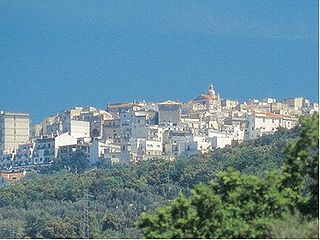
Ischitella is a town and comune in the province of Foggia, Apulia, southeast Italy. It is a centre for agrumes production, on the northern slopes of the Gargano promontory.
Carosino is a town and comune in the province of Taranto, in the northern Salento, part of the Apulia region of southeast Italy. Carosino was historically an Arbëreshë settlement. Its economy is based on the production of wine, olive oil and grapes.

Maruggio is a village and comune in the province of Taranto, Apulia, southeast Italy. The village is located in a natural depression 2 kilometres (1.2 mi) from the Gulf of Taranto, in the north-west part of Salento peninsula and it's one of the villages of South Italy where the Greek dialect Griko is spoken.

San Giorgio Ionico is a town and comune in the province of Taranto, in the northern Salento, part of the Apulia region of southeast Italy. San Giorgio Ionico was historically an Arbëreshë settlement. After the inhabitants abandoned the Albanian Greek Orthodox faith they assimilated into the local population.

Torricella is a town and comune in the province of Taranto, in the Apulia region of southeast Italy. It is home to a large tuff castle from the 15th century, one of the best preserved in the region.
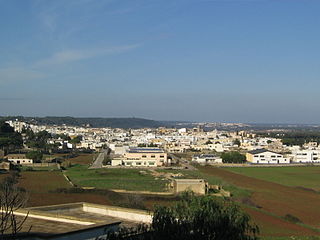
Alessano is a town and comune in the province of Lecce, part of Apulia region of south-east Italy.

Morciano di Leuca is a town and comune of 3,121 inhabitants in the province of Lecce, in the Apulia region of south-east Italy.
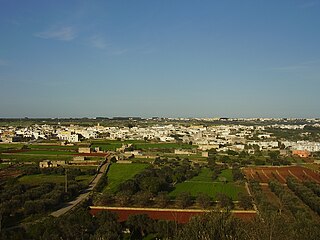
Patù is a town and comune in the province of Lecce in the Apulia region of south-east Italy.

Salve is a town and comune of 4,546 inhabitants of the province of Lecce, in the region of Apulia, south-east Italy.




